
|   |

|   |
Guru Aloka Panikar: Orissi Odyssey - Ashish Mohan Khokar, Bangalore e-mail: mr.dancehistory@gmail.com Photos: Mohan Khokar Dance Collection January 4, 2011 Aloka Panikar was born in the picturesque coastal town of Chittagong (present Bangladesh) on the 26th of November 1940, to Nirendra Kumar Bhattacharjea and Karunamayi Devi. She was a pretty baby, very fair and the moment the midwife saw her she exclaimed, "Aah, she has lit up the room; there is light!" So the little girl was fondly nicknamed 'Aalo', light! Later she was given a proper name Aloka and that too was a derivative of the word that the midwife had first uttered. Aloka was a sickly baby and always seemed to contract every childhood malady more severely than her other siblings. When she was not even three years old, the family moved to Kolkata upon the advice of the family physician who felt that the climate of Chittagong was not suitable for the toddler. Since her childhood, Aloka was drawn to dance and was naturally, a favourite of the dance teacher at Kamala Girls High School that she attended with her siblings. During one of the school functions, the Governor of West Bengal, Kailash Nath Katju, was invited to be the chief guest. Little Aloka, dressed as a leaf, all in green, was asked to garland him and honour him. The Governor garlanded her back and laughingly said to her that now she was married to him. The shy child did not quite understand what he meant but she worried nonetheless if the "marriage" implied that she would have to leave her parents and siblings to go and live with strangers! For the next few years, until the family moved to New Delhi, Aloka actively participated in all the cultural programmes at school, sometimes even performing small important roles. Her older sister Jayashree was a natural singer, gifted with a sweet and melodious voice. Their father was very proud of this talented child of his and enrolled her in a well known institution of music. Aloka would wistfully watch the older sibling being chauffer driven to her music classes. Their mother secretly felt sad for her younger daughter whom all had written off as sickly and with no special talents. During that period, a gentleman by the name of Vishwanath Bhattacharya became a tenant of the family. He was a music teacher by profession and went out giving tuitions in Hindustani classical vocal music. Aloka's mother requested the gentleman to teach her younger daughter too. He agreed but said that the only time he could give her daughter tuition was at night after he returned from his daylong round of tuitions. The mother agreed and little Aloka would wait for her music lessons eagerly, even though they were held at her bedtime. Her guru started taking her along to attend music concerts and the little girl grew up listening to some of the great musicians of those times. One day, making sure that Aloka was listening to the conversation, her guru, with a serious face, started telling her mother that if one sat neck-deep in water late at night, it worked wonders on the voice and many famous singers had tried this with great success. Now Aloka was determined to be a great singer, so late at night she made her way to the courtyard where water used to be stored in a cement reservoir. She had almost stepped into the water when she was spied by somebody in the household. On being questioned, when she gave the reason behind such a drastic step, her mother's eyes filled up with tears as she laughingly embraced her daughter and explained that her guru had been joking. So, determined to be a good singer, the child practiced hard and eventually went on to win the first prize in a classical music competition for children. Sadly though, the guru moved to another accommodation and Aloka's music lessons stopped right there. As she grew older, Aloka was every bit a tomboy; running about playing boyish games with her younger brother Ashok and his friends, much to the despair of her mother, especially as the child mostly returned home from her games, covered in scratches and bruises. Aloka's life changed rather abruptly when her younger brother and dearest playmate suddenly died of meningitis. She was just eleven years old then. It was as though almost overnight, from an ebullient tomboy, Aloka metamorphosed into a reserved girl of eleven years. Soon after, the family moved once again, and this time to New Delhi. All the daughters were admitted into Vidya Bhavan, a well known school for the Bengali gentry. The only surviving son was admitted into Raisina Public school. It was in this school that Aloka's dancing talents were brought to the fore. The dance teacher at Vidya Bhavan, Valmiki Banerjee, was a well known choreographer, well versed in Kathakali and Mohiniattam. He was the disciple of the renowned Kathakali maestro, Guru Gopinath. The founder principal of the school Sudhanshu Sanyal, loved the performing arts and with her heading the institution, Valmiki Banerjee composed and choreographed many dance dramas; Daksha Yagnya, The life of Lord Buddha and many other small items of folk dances and the Indian creative style, much to the delight of all. Aloka and few other talented students of Vidya Bhavan were a permanent part of his productions. 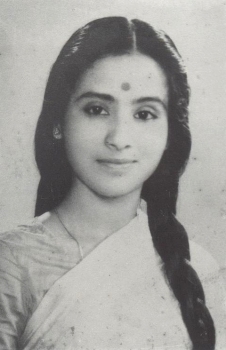 Though Aloka's father did not mind his daughter participating in school functions, especially since the teachers liked her dance, he was opposed to the idea of any child of his taking more than a passing interest in dance. According to him, girls from high class Brahmin families did not dance; it just was not respectable enough! Aloka could learn music if she was so inclined. In fact, being a very short-tempered man, he once told the mother, if any of his daughters ever even thought of dancing on stage then he would break her legs! Ironically, it was her father who bought Aloka her first patola sari for making a costume when later he saw her perform 'Dasavatara' on stage! At that point, Valmiki Banerjee had started a dance school of sorts. He brought two more people; Gopal Chatterjee, a Bharatanatyam teacher and Krishnaprasad Sinha, a Manipuri teacher. They too started teaching at his school. His school attracted many students. Aloka's mother realized that her daughter had a talent for dance and so, without telling her husband, she gave permission to Aloka to learn dance at Valmiki Banerjee's school. So Aloka started to formally learn dance for the first time. This was in the mid-1950's. She learnt a little bit of everything; Kathakali, Mohiniattam, Bharatanatyam and Manipuri. The aim was just to be a very good dancer and perform; folk dances, creative or whatever the teacher wanted his students to perform. Unfortunately, just when Aloka was progressing beyond being a novice, owing to personal reasons, the family had to move again, this time to Aligarh. The family stayed with Aloka's paternal uncle who also had a large family of his own. Now Aloka was in an environment totally devoid of dance. She and her older sister Jayashree were the oldest of all the children, siblings and cousins included. So their aunt, basically a kind and affectionate woman, made these two sisters take charge of the rest of the children. Time passed and the two older sisters finished matriculation in Aligarh. Though there were no dance and music lessons, Jayashree, who was a very talented singer and a very creative person along with Aloka, ended up composing dance pieces titled 'Madan-Rati' and 'Satyavan-Savitri' for their school functions. Aloka was cast as 'Rati' in one and as 'Yama' in the other one! In a place like Aligarh, deprived of anything artistic, all such artistic effort received a lot of applause. After living in Aligarh for two years, the family once again returned to Delhi. Due to the long gap in her dance training, Aloka gave up all aspirations where dance was concerned and enrolled in Irwin Hospital (Presently the Lok Nayak Jaiprakash Narayan Hospital) to train as a nurse. When she joined, there were just three months left to that semester. So with sheer hard work, Aloka managed to finish the semester and passed with very good grades. In her second year in nursing, Aloka was put in the children's ward. While she was very good with children and enjoyed being with them, seeing many of the very small patients die finally got to her, and she decided to give up the pursuit of nursing. 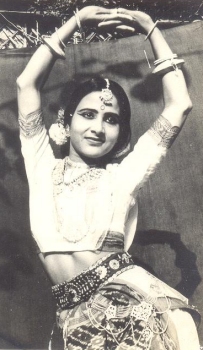 One day, after she gave up nursing, one of her friends, a girl called Annapurna came to visit her. Annapurna had been a fellow student with her in Valmiki Banerjee's classes. Brimming over with excitement, Annapurna told her about this wonderful place that taught dance and also gave you a stipend! This place was the Bharatiya Kala Kendra (Present Shriram Bharatiya Kala Kendra). And as though that was not enough, the chief choreographer was none other than their guru's teacher, Guru Gopinath! Aloka immediately told her mother that she wanted to work in this institution. With both Aloka and Annapurna applying pressure on her, the mother finally gave in. But, she warned them, this time Aloka's father had to be convinced as she could not hide all this from him for long. This was truly an uphill task, but mother and daughter managed to convince the father. In spite of a closed mind regarding dance not being a respectable profession, the gentleman had enough respect for the arts, having worked in theatre and films and having been a successful film distributor in Kolkata, working with the likes of Pramathesh Baruah. So the name of Guru Gopinath was enough to convince him that his daughter was not entering some sleazy set up. This was how in 1959, Aloka Bhattacharjea came to be a staff artiste at the Bharatiya Kala Kendra. Bharatiya Kala Kendra then had an annual production called 'Ramlila' which was put up every year during the period of Dussehra. When she and Annapurna went for an audition, they were interviewed by K Shekharan, senior dancer and staff artiste. He put them through a gruelling interview and would probably have made it very hard for them to be selected, but they were rescued by the maestro Guru Gopinath himself. He could see that the girls were talented but his senior disciple was being exceptionally hard with them. Though Aloka did not know it then and mentally labelled K Shekharan as a vain person, she had met her future husband! Once at Bharatiya Kala Kendra, Aloka made rapid progress in dance. Gifted with winsome stage presence, genuine talent, a fine mind and the desire to excel, Aloka soon became a dancer to watch. Trained by Guru Gopinath and other seniors, she soon progressed from being one of the group to being the lead dancer, and then to the coveted role of 'Sita' in Ramlila. Sumitra Charatram, the head of Bharatiya Kala Kendra was very fond of Aloka and her dance, and even much later, when Aloka left the ballet unit of Bharatiya Kala Kendra to concentrate solely on Orissi, Mrs. Charatram always encouraged Aloka. On the 11th of August 1960, Aloka married K Shekharan Panikar and became Aloka Panikar. And so started a new chapter in Aloka's life. It seemed as though Aloka was meant to break every rule that had been set down in her family! She became a professional dancer. She was the first of her siblings to marry and that too, a man from Kerala who was not a Brahmin! This was too much for her father to take and in a fit of temper, he told Aloka's mother that Aloka should leave home in whatever she was wearing, that he did not approve of the match and therefore, was not going to spend a penny for the marriage. Of course, later the wedding was attended by all family, including cousins, but the father did not attend the wedding. The 'kanyadaan' was performed by one of her older cousins who had come from Kolkata. Aloka's pride was hurt by her father's behaviour and she truly left home in just the clothes that she was wearing. Needless to say, she proved her father wrong again as Shekharan was the dearest son-in-law of the family, more like a son. 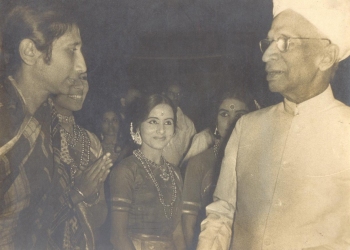 With VIP visitor at Ramlila, President Radhakrishnan So life went on. It was not easy for the young couple. There was too much work and not enough money. To supplement their income, Aloka and Shekharan, along with some other colleagues formed a little group and would often put up performances. Their repertoire comprised of folk dances, dance dramas based on Tagore's poetry, and small episodes based on mythological stories. All these people, including Krishnan Nambudiri were at one point part of the IPTA (The Indian Peoples' Theatre Association), and under the IPTA banner, put up many performances in different parts of the country. In the April of 1962, a daughter, their only offspring, was born to them. The couple soon realised how difficult it was to look after a new born infant without any help at hand. They were both employed at the Bharatiya Kala Kendra, working 10am-5pm and there was no extended maternity leave those days. So, even though the couple lived right next to the hall where rehearsals were held, at times Aloka could not come to feed her baby who would, of course, be bawling her lungs out. During one such occasion, Aloka's mother, accompanied by Aloka's younger sister Anuradha, came to visit her grandchild. She was angry and appalled to see the six month old baby, alone in the room and crying with hunger. She told Aloka that she was taking the baby home as Aloka clearly needed to work and had no support system. From that day, until the child was old enough to go to school, she lived with her grandparents, spoilt silly by them and all the doting aunts and uncle. And though Aloka had no choice but to send her daughter away, she and Shekharan visited their daughter every evening after they had finished for the day as Aloka was afraid that the child might forget her parents and not be able to bond with them later. Those days, Guru Harekrushna Behara, a teacher of Orissi, had come to Delhi on a scholarship from Orissa to learn Kathak. Shekharan asked him if he would teach Aloka an Orissi item that she could perform at the Delhi Malayalees Association's Onam celebrations. So Aloka was taught batu nritya by Harekrushna Behera. That was Aloka's first encounter with Orissi. After the performance was over, every one raved about it and all including Harekrushna Behera told Aloka she must learn Orissi properly. Orissi was still a new style in Delhi and initially, Aloka was not very confident about it but egged on by her husband, who said the style suited her a lot and seemed to have a lot of potential, she ultimately took to it, very naturally and spontaneously. This was in 1964. She would do her lessons with Hari babu, (as Harekrushna Behera was known then) in the morning. Afterwards she would go off to her job at Bharatiya Kala Kendra. Few months after she started learning Orissi, Haribabu started taking her along to the places where he conducted his other classes. So after dancing through the day at Bharatiya Kala Kendra, she had to accompany her guru and help him with his tuitions. At times it was very tiring, but her husband who was devoted to his own guru, always told her that she had to work very hard if she wanted to achieve something in life. He strongly believed that the guru's blessing was very important for a disciple. Gradually Aloka started to present short Orissi recitals. She was one of the first Orissi dancers to perform at the 'Young Dancers Festival' organized by the Sangeet Natak Akademi in the Delhi of the 60's. In 1968, Indrani Rehman came to see 'Ramlila' which used to be presented at the Feroz Shah Kotla grounds and was a grand spectacle. Indrani had already worked with Shekharan and taken him abroad as part of her troupe. But now she was looking out for a good female dancer. In 'Ramlila' she saw Aloka dancing in the group, and without even knowing that Aloka was married to Shekharan, she made a mental selection of Aloka for her group. Later she was thrilled to learn that Aloka and Shekharan were married to one another, as that made things much easier for her. So the first time that Aloka travelled abroad to USA was with her husband, as part of Indrani Rehman's troupe. 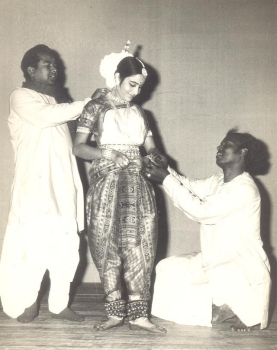 Guru Mayadhar prepares Aloka Panikar for stage while husband K Shekharan Panikar admires and puts alta! Another significant thing happened that year. It was in the year 1968 that Aloka Panikar met Guru Mayadhar Raut. He had been called to Delhi by Hari babu to teach at Nritya Niketan. Aloka, who went there for her classes with Hari babu, also attended a few of Mayadhar Raut's classes and realised how much more there was to Orissi. Hari babu one day told her in a fit of anger that she should, henceforth, learn only from Mayadhar as he would not teach her any longer. Aloka was distraught at the harsh words of her guru and asked him what her crime was but he neither gave her any reason, nor did he relent. A saddened Aloka had no choice but to go to Mayadhar Raut's classes. The partnership proved beneficial for both guru and shishya. Under Mayadhar Raut's guidance, Aloka's dance flourished and her abhinaya acquired depth and maturity, whereas seeing Aloka's numerous performances, many students now flocked to learn from Mayadhar Raut. It was a period filled with creative energy. Mayadhar Raut choreographed some dance-dramas in Orissi - Konark and Krushna Gatha to name a few. He had a lot of young and talented students then and all the presentations, with Aloka Panikar playing lead roles, received very good reviews. Later, it was Aloka and her husband, Shekharan who spoke to Mrs. Charatram and convinced her to start an Orissi dance section at the Bharatiya Kala Kendra in the early 70's. Once Mayadhar Raut joined the faculty, he choreographed the dance drama 'Gita Govinda' with Aloka Panikar and E Mukundan enacting the lead roles of Radha and Krishna. The dance drama had been choreographed for the inaugural opening of the Kamani auditorium in 1971. The 'Gita Govinda' was also presented at the Rashtrapati Bhavan, with Mayadhar Raut himself enacting the role of Krishna while Aloka Panikar was Radha. It was during this period that Aloka Panikar was invited to perform in Orissa as a state guest by Dhirendranath Patnaik, secretary of Orissa Sangeet Natak Akademi. After her performance, a local Oriya daily said "wonderful Orissi dance by a non-Oriya girl"! In 1973, Aloka decided that she had had enough of being in the ballet unit of Bharatiya Kala Kendra and that she would henceforth focus only on Orissi and on being a performer and teacher of that style. Her husband was not so sure, but in the end he gave in and Aloka resigned from her job at the Bharatiya Kala Kendra. But she was still attached to the Bharatiya Kala Kendra as her guru's assistant in the Orissi section. Now all her time was being freely given to Orissi. When her guru was invited to start an Orissi dance class at the Neelachala Sewa Sangh in Delhi, along went Aloka to teach the new generation of students. It was in 1973 that Aloka was invited to perform in Paris in the prestigious International Dance and Music Festival that was to be held at the Theatre de la Ville. That was Aloka's first tour abroad as a soloist. The organizer of the festival, Mr. Jean Mercure, visited many art institutions and saw many artistes perform in India before he made his final selection. Those who finally made it into his list were Birju Maharaj and his troupe, the Dhananjayans, Aloka Panikar, Alarmel Valli, Shivkumar Sharma and Hariprasad Chaurasia. Later, a senior dancer of Orissa came and fought with Aloka, accusing her of stealing her chance to perform at Paris. 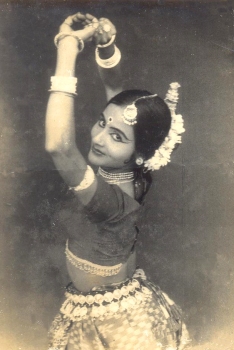 Aloka Panikar in Orissi Then started a wonderful phase of dance in Aloka's life! She performed, taught, travelled and there was only Orissi everywhere. She was also supported by Sumitra Charatram who recommended her name to all suitable platforms and by Mohan Khokar, secretary, Sangeet Natak Akademi. So she performed at some of the prestigious festivals like the Khajuraho festival, the Chitrakoot Festival, The Haridas Sammelan, the UDCO festival to name a few. While Indira Gandhi was the Prime Minister, Aloka also had the opportunity to perform a couple of times at the Rashtrapati Bhavan. In 1977, she collaborated with reputed scholar and then Secretary of Sangeet Natak Akademi, Prof. Mohan Khokar and Prof. Feruccio Marotti of Italy to make a full length film on Orissi for the theatre department in the University of Rome. From 1978 onwards, she travelled to Italy every year, collaborating with the director, Prof Renzo Vescovi and the artistes of Teatro Tascabile di Bergamo in Bergamo. They became her organizers in Italy and invited her every year to perform and to conduct workshops all over Italy. In fact some of the senior Orissi dancers at that theatre have been her students since the past three decades. Aloka Panikar met with an accident that left her with a head and eye injury. This was in September 1985. A brilliant artiste was suddenly left half-crippled, bereft of the one thing that she loved most. It was a big shock to the entire family, her students and even those who enjoyed her dance. Her mother could not believe that the daughter who had been dancing since childhood would probably never dance again. Her husband, who had sat many hours, working with her guru over each new item that was composed for her, could not believe his eyes when he saw her in the hospital, looking like a broken doll. He himself was very ill those days, having been diagnosed with cancer. Though the broken figurine never fully recovered, to cheer her husband and to make him believe that she was much better, within a month of her accident, she resumed teaching at home. But her husband steadily grew worse and passed away the following year, in February 1986. It seemed that there was more sorrow in store for her. Aloka lost her mother the following year. Losing her husband and then her mother so soon, in quick succession of each other was a traumatic experience for Aloka. With their deaths, she had lost two of her staunchest supporters, where dance was concerned, as also two of the people who had loved her unconditionally. She was shattered but did not give up. Aided by her daughter Ambika, who by then was a trained dancer, she continued to teach. Some of the students she trained while she was an active dancer herself, and who later on achieved praise for their purity of style are Rajshri Gupta (Aloka's younger sister), Sahana Misra, Tiziana Barbiero and Luigia Calcaterra (Italy), Dali Basu and Sonia St. Michel (Canada), Nivedita Mohapatra and Aloka's daughter Ambika Paniker among others. Her connection with Italy still intact, every year students come from Italy and other places like Canada and Argentina, for intensive training with Aloka and her daughter. Anyone else in her place would have given up. But even now, at seventy years of age, she teaches with the same dedication, precision and involvement as she did when she was younger. It is no surprise then that she is regarded as a wonderful teacher and loved by all her students. Aloka Panikar is based in Delhi, where she lives with her daughter Ambika and son-in-law Kailash Sharma, an eminent flautist.  Ashish Mohan Khokar has made writing and recording dance history his mission. As a merit-lister in M.A. History from the Delhi University, he loves the process and technique of writing history and its reconstruction. He is the most sought-after biographer because of this and his 30 years of direct dance writing, with 35 published titles to credit, makes him India's reputed dance historian. With practical background in dance and theory, his opinions are much sought after and respected. He wrote as dance columnist for many magazines like India Today, First City and Life Positive. He was the dance critic of the Times of India in Delhi, then Bangalore, before starting his own dance journal - attendance - now in its 12th year of publication. As India's pioneering arts administrator way back in mid-eighties, he served the Delhi State Akademi and the Festivals of India in France, Sweden, Germany and China and worked as one of the Directors at INTACH, under PM, Rajiv Gandhi's chairmanship. He is currently on many committees and boards, nationally and internationally. attendance-india.com ; dancearchivesofindia.com |